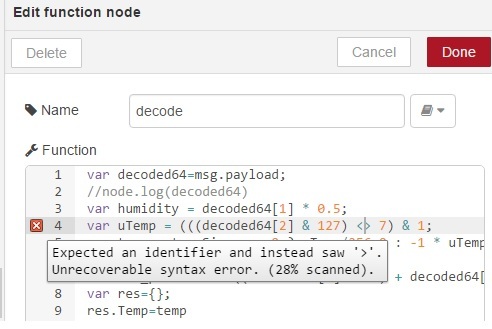Hi I ’ ve managed to decode RuuviTag readings via PhysicalWeb node avaialable . the flow below contains upload to google.docs and visualsiation on node-red dasboard:
[{“id”:“7543a7b7.449e58”,“type”:“PhysicalWeb in”,“z”:“b773c68.2f29c38”,“name”:"",“topic”:"",“duplicates”:true,“x”:98.83332824707031,“y”:47,“wires”:[[“a419f065.47f74”]]},{“id”:“e907ae2c.aca54”,“type”:“debug”,“z”:“b773c68.2f29c38”,“name”:"",“active”:true,“console”:“false”,“complete”:“true”,“x”:806.8332824707031,“y”:376.99998474121094,“wires”:[]},{“id”:“b53412c0.4fbcb”,“type”:“base64”,“z”:“b773c68.2f29c38”,“name”:"",“x”:624.8333129882812,“y”:44.33331298828125,“wires”:[[“61f8ea0.8837918”]]},{“id”:“8579b9e0.db4708”,“type”:“rbe”,“z”:“b773c68.2f29c38”,“name”:"",“func”:“rbe”,“gap”:"",“start”:"",“inout”:“out”,“x”:454.83326721191406,“y”:45,“wires”:[[“b53412c0.4fbcb”]]},{“id”:“a419f065.47f74”,“type”:“function”,“z”:“b773c68.2f29c38”,“name”:“url extract”,“func”:"\nvar lastFive = msg.payload.url.substr(msg.payload.url.length - 8)\nvar newMsg = { payload: lastFive };\nreturn newMsg;",“outputs”:1,“noerr”:0,“x”:290.8332977294922,“y”:45.66668701171875,“wires”:[[“8579b9e0.db4708”]]},{“id”:“61f8ea0.8837918”,“type”:“function”,“z”:“b773c68.2f29c38”,“name”:“decode”,“func”:" var decoded64=msg.payload;\n //node.log(decoded64)\n var humidity = decoded64[1] * 0.5;\n var uTemp = (((decoded64[2] & 127) << 8) | decoded64[3]);\n var tempSign = (decoded64[2] >> 7) & 1;\n var temp = tempSign === 0 ? uTemp/256.0 : -1 * uTemp/256.0;\n var tempF = temp * 1.8 + 32;\n var air_pressure = ((decoded64[4] << 8) + decoded64[5]) + 50000;\n var res={}; \n res.Temp=temp\n res.Humidity=humidity;\n res.Pressure=air_pressure/100;\n //node.log( res)\n var newMsg={ payload: res };\nreturn newMsg;",“outputs”:1,“noerr”:0,“x”:612.8333282470703,“y”:169.00003051757812,“wires”:[[“d9bb357f.34a728”,“5c86ba88.a3f484”,“291bb3a6.38721c”,“5e89fce2.adc8a4”,“e907ae2c.aca54”]]},{“id”:“d9bb357f.34a728”,“type”:“http request”,“z”:“b773c68.2f29c38”,“name”:"",“method”:“GET”,“ret”:“txt”,“url”:“https://docs.google.com/forms/d/e/1FAIpQLSe5y3kieN8awamZH8mddJW8_9TkwCxi_mh38JfxTX6bLN3mWw/formResponse?entry.2129173735={{payload.Temp}}&entry.1724609919={{payload.Humidity}}&entry.392458147={{payload.Pressure}}”,“tls”:"",“x”:848.8332977294922,“y”:103.66665649414062,“wires”:[[]]},{“id”:“37d04bf0.89a474”,“type”:“ui_gauge”,“z”:“b773c68.2f29c38”,“name”:“temp”,“group”:“dcdcb16a.e1794”,“order”:1,“width”:0,“height”:0,“gtype”:“gage”,“title”:“Gauge”,“label”:“units”,“format”:"{{value | number :0 }}C",“min”:"-20",“max”:“50”,“colors”:["#00b500","#e6e600","#ca3838"],“x”:1032.8333587646484,“y”:29.6666259765625,“wires”:[]},{“id”:“5c86ba88.a3f484”,“type”:“function”,“z”:“b773c68.2f29c38”,“name”:“Temp gauge”,“func”:“return {payload:msg.payload.Temp}”,“outputs”:1,“noerr”:0,“x”:854.8332977294922,“y”:29.66668701171875,“wires”:[[“37d04bf0.89a474”]]},{“id”:“5e89fce2.adc8a4”,“type”:“function”,“z”:“b773c68.2f29c38”,“name”:“Humidity Gauge”,“func”:“return {payload:msg.payload.Humidity}”,“outputs”:1,“noerr”:0,“x”:854.8332977294922,“y”:169.66668701171875,“wires”:[[“f2748697.ed1178”]]},{“id”:“291bb3a6.38721c”,“type”:“function”,“z”:“b773c68.2f29c38”,“name”:“Pressure Gauge”,“func”:“return {payload:msg.payload.Pressure}”,“outputs”:1,“noerr”:0,“x”:846.8333282470703,“y”:259.6666717529297,“wires”:[[“8c5e9d0c.1cd61”]]},{“id”:“8c5e9d0c.1cd61”,“type”:“ui_gauge”,“z”:“b773c68.2f29c38”,“name”:"",“group”:“b99d7751.f24e88”,“order”:1,“width”:0,“height”:0,“gtype”:“gage”,“title”:“Pressure”,“label”:“units”,“format”:"{{value}}",“min”:“800”,“max”:“1050”,“colors”:["#00b500","#e6e600","#ca3838"],“x”:1032.8333587646484,“y”:260.3332824707031,“wires”:[]},{“id”:“f2748697.ed1178”,“type”:“ui_gauge”,“z”:“b773c68.2f29c38”,“name”:"",“group”:“2bcb7a68.a61ad6”,“order”:0,“width”:0,“height”:0,“gtype”:“gage”,“title”:“Humidity”,“label”:“units”,“format”:"{{value}}%",“min”:0,“max”:“120”,“colors”:["#00b500","#e6e600","#ca3838"],“x”:1034.8333587646484,“y”:170.33331298828125,“wires”:[]},{“id”:“dcdcb16a.e1794”,“type”:“ui_group”,“z”:"",“name”:“Group”,“tab”:“3ec967de.6c75c8”,“order”:null,“disp”:false,“width”:“6”},{“id”:“b99d7751.f24e88”,“type”:“ui_group”,“name”:“Group”,“tab”:“3ec967de.6c75c8”,“order”:null,“disp”:true,“width”:6},{“id”:“2bcb7a68.a61ad6”,“type”:“ui_group”,“name”:“Group”,“tab”:“3ec967de.6c75c8”,“order”:null,“disp”:true,“width”:6},{“id”:“3ec967de.6c75c8”,“type”:“ui_tab”,“z”:"",“name”:“Tab 1”,“icon”:“dashboard”,“order”:1}]
